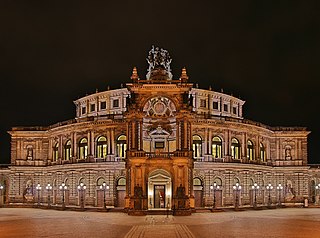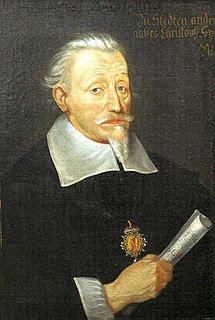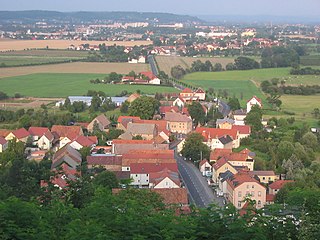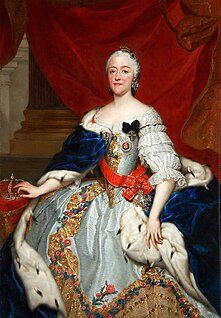
Dresden is the capital city of the German state of Saxony and its second most populous city, after Leipzig. It is the 12th most populous city of Germany, the fourth largest by area, and the third most populous city in the area of former East Germany, following only (East) Berlin and Leipzig. Dresden's urban area comprises the towns of Freital, Pirna, Radebeul, Meissen and Coswig and has around 790,000 inhabitants. The Dresden metropolitan region has approximately 1,34 million inhabitants.

The Staatskapelle Dresden is a German orchestra based in Dresden, the capital of Saxony. Founded in 1548 by Maurice, Elector of Saxony, it is one of the world's oldest and highest ranked orchestras. Its precursor ensemble was Die Kurfürstlich-Sächsische und Königlich-Polnische Kapelle. The orchestra is the musical body of the Staatsoper Dresden. The venue of the orchestra is the Semperoper.

Heinrich Schütz was a German composer and organist, generally regarded as the most important German composer before Johann Sebastian Bach, as well as one of the most important composers of the 17th century. He is credited with bringing the Italian style to Germany and continuing its evolution from the Renaissance into the Early Baroque. Most of his surviving music was written for the Lutheran church, primarily for the Electoral Chapel in Dresden. He wrote what is traditionally considered to be the first German opera, Dafne, performed at Torgau in 1627, the music of which has since been lost, along with nearly all of his ceremonial and theatrical scores.

The Battle of Dresden was a major engagement of the Napoleonic Wars. The battle took place around the city of Dresden in modern-day Germany. With the recent addition of Austria, the Sixth Coalition felt emboldened in their quest to expel the French from Central Europe. Despite being heavily outnumbered, French forces under Napoleon scored a victory against the Allied army led by Field Marshal Schwarzenberg. However, Napoleon's victory did not lead to the collapse of the coalition, and the lack of effective French cavalry units, caused by a very heavy loss of French horses during the past 1812 French invasion of Russia, precluded a major pursuit. Three days after the battle, the Allies surrounded and captured a French corps at the Battle of Kulm.

Johann Adolph Hasse was an 18th-century German composer, singer and teacher of music. Immensely popular in his time, Hasse was best known for his prolific operatic output, though he also composed a considerable quantity of sacred music. Married to soprano Faustina Bordoni and a great friend of librettist Pietro Metastasio, whose libretti he frequently set, Hasse was a pivotal figure in the development of opera seria and 18th-century music.

Augustus III was King of Poland and Grand Duke of Lithuania from 1734 until 1763, as well as Elector of Saxony in the Holy Roman Empire from 1733 until 1763 where he was known as Frederick Augustus II.

Nicola (Antonio) Porpora was an Italian composer and teacher of singing of the Baroque era, whose most famous singing students were the castratos Farinelli and Caffarelli. Other students included composers Matteo Capranica and Joseph Haydn.
Jan Dismas Zelenka, baptised Jan Lukáš Zelenka and also known as Johann Dismas Zelenka or Johannes Lucas Ignatius Dismas Zelenka, was a Czech composer and musician of the Baroque period. His music is admired for its harmonic inventiveness and counterpoint.

Johann David Heinichen was a German Baroque composer and music theorist who brought the musical genius of Venice to the court of Augustus II the Strong in Dresden. After he died, Heinichen's music attracted little attention for many years.

The Symphony No. 5 in D major/D minor, Op. 107, known as the Reformation, was composed by Felix Mendelssohn in 1830 in honor of the 300th anniversary of the Presentation of the Augsburg Confession. The Confession is a key document of Lutheranism and its Presentation to Emperor Charles V in June 1530 was a momentous event of the Protestant Reformation. This symphony was written for a full orchestra and was Mendelssohn's second extended symphony. It was not published until 1868, 21 years after the composer's death – hence its numbering as '5'. Although the symphony is not very frequently performed, it is better known today than when it was originally published. Mendelssohn's sister, Fanny Mendelssohn Hensel, chose the name Reformation Symphony.

Coswig is a town in the district of Meißen, in the Free State of Saxony, Germany. It is situated on the right bank of the Elbe, approximately 9 km southeast of Meißen, and 13 km northwest of Dresden. It is the home of Fachkrankenhaus Coswig, a hospital specializing in thoracic surgery.
Johann Walter, also known as Johann Walther or Johannes Walter was a Lutheran composer and poet during the Reformation period.

Johann Gottlieb Naumann was a German composer, conductor, and Kapellmeister.

Maria Antonia, Princess of Bavaria, Electress of Saxony was a German princess, composer, singer, harpsichordist and patron, known particularly for her operas Il trionfo della fedeltà and Talestri, regina delle amazoni. She was also the Regent of Saxony in 1763-1768. Baptised Maria Antonia Walpurgis Symphorosa, she was known as Maria Antonia.

The Dresdner Kreuzchor is the boys' choir of the Kreuzkirche in Dresden, Germany. It has a seven-century history and a world-wide reputation. Today, the choir has about 150 members between the ages of 9 and 19, from Dresden and the surrounding region. The boys attend the Kreuzschule in Dresden. They are also called "Kruzianer".

Cornelius Gustav Gurlitt was a German architect and art historian.
Torsten Rasch is a German composer of contemporary classical music. He lives in Berlin, but has found moderate success in the UK.

Dresden is a southern district of Stoke-on-Trent, Staffordshire, England, on Trentham Road (A5035) south of Longton.

Theodor Uhlig was a German violin-player, composer and music critic.

The Carl Maria von Weber Museum is a cultural site in Dresden, in Saxony, Germany. The composer Carl Maria von Weber (1786–1826) lived here during part of his career; the house is now a museum about his life and work.



















